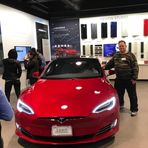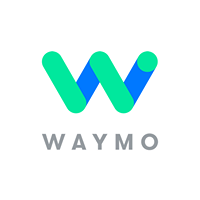Zoox Ramps Up Robotaxi Production: A New Era in Autonomous Ridesharing
June 19, 2025, 4:40 pm

Location: United States, California, Foster City
Employees: 1001-5000
Founded date: 2014
Total raised: $700M

Location: United States, Texas, Austin
Employees: 10001+
Founded date: 2003
Total raised: $3.86B

Location: United States, California, Mountain View
Employees: 1001-5000
Founded date: 2009
Total raised: $19.17B
In the bustling world of autonomous vehicles, Zoox is making waves. The Amazon-owned startup has officially opened its first serial production facility in Hayward, California. This marks a significant leap toward launching a commercial robotaxi service that aims to rival established players like Waymo and Tesla. With the ambition to produce 10,000 robotaxis annually, Zoox is gearing up for a ride-hailing revolution.
The Hayward facility spans 220,000 square feet, a space where innovation meets assembly lines. Currently, Zoox is producing one robotaxi per day. However, the company has set its sights on ramping up production to three vehicles per hour. This is not just a factory; it’s a launchpad for the future of transportation.
Zoox’s robotaxis are unlike anything on the road. They resemble boxy, gondola-like carriages, designed for comfort and efficiency. With seating for up to four passengers, these vehicles lack traditional controls like steering wheels. Instead, they are high-end computers on wheels, engineered for a seamless ride. This design sets Zoox apart from competitors like Waymo, which retrofits existing vehicles. Zoox is creating a new category of transport.
The company’s plans extend beyond Hayward. By 2027, Zoox aims to deploy its fleet in major markets such as Miami, Los Angeles, and Atlanta. The goal is to operate between 500 and 1,000 robotaxis in smaller cities and around 2,000 in larger urban areas. This ambitious expansion is fueled by the growing demand for autonomous ride-hailing services.
Testing is already underway in cities like San Francisco and Las Vegas. Zoox has a few dozen vehicles on public roads, preparing for a commercial launch in Las Vegas later this year. San Francisco will follow in 2026, with additional locations planned for Austin and Miami. The rollout will allow riders to hail a robotaxi via an app, similar to existing services like Uber and Lyft.
However, the road to success is not without obstacles. Zoox faces stiff competition from Waymo, which has been operating a fully public driverless ride-hailing service for years. Waymo has expanded aggressively, providing over 250,000 paid trips weekly across several major cities. Meanwhile, Tesla is also gearing up to launch its robotaxi service, with plans to debut in Austin soon.
Despite the competition, Zoox remains optimistic. The company believes its unique design and purpose-built vehicles will attract riders. The robotaxis are not just a means of transport; they represent a shift in how we think about mobility. Zoox’s CEO has expressed pride in the progress made by competitors, viewing it as validation of the entire industry’s efforts.
The manufacturing process at the Hayward facility is meticulous. Each vehicle undergoes rigorous testing, including calibration of cameras and sensors, stress tests of the powertrain, and even simulated rainstorms to check for leaks. This attention to detail ensures that every robotaxi is road-ready before it hits the streets.
Zoox’s production facility employs around 100 technicians, with robots assisting in various tasks. This blend of human skill and automation is a glimpse into the future of manufacturing. As production scales up, Zoox expects the cost of each vehicle to decrease, making the service more accessible.
The company is also navigating the complexities of supply chains. About half of its parts are sourced domestically, while the rest come from international suppliers. This strategy helps mitigate risks associated with tariffs and trade policies, which have become increasingly relevant in today’s economic landscape.
Marketing efforts are ramping up as Zoox prepares for its public launch. The company recognizes that its robotaxis look different from traditional vehicles, necessitating a strong branding strategy. As they gear up for the commercial rollout, Zoox is not just selling rides; they are selling a vision of the future.
The journey ahead is filled with challenges. Regulatory hurdles, safety concerns, and public perception will all play crucial roles in Zoox’s success. The autonomous vehicle industry has faced scrutiny, with several companies, including Zoox, experiencing recalls and investigations following incidents on the road. Safety remains a top priority, and Zoox is committed to ensuring its vehicles are safe for public use.
In conclusion, Zoox is at the forefront of a transportation revolution. With its new production facility, the company is poised to change the way we think about getting from point A to point B. As they prepare for commercial launches in Las Vegas and beyond, the world will be watching. Will Zoox carve out its niche in the competitive landscape of autonomous ridesharing? Only time will tell, but one thing is clear: the future of mobility is here, and it’s taking shape in Hayward, California.
The Hayward facility spans 220,000 square feet, a space where innovation meets assembly lines. Currently, Zoox is producing one robotaxi per day. However, the company has set its sights on ramping up production to three vehicles per hour. This is not just a factory; it’s a launchpad for the future of transportation.
Zoox’s robotaxis are unlike anything on the road. They resemble boxy, gondola-like carriages, designed for comfort and efficiency. With seating for up to four passengers, these vehicles lack traditional controls like steering wheels. Instead, they are high-end computers on wheels, engineered for a seamless ride. This design sets Zoox apart from competitors like Waymo, which retrofits existing vehicles. Zoox is creating a new category of transport.
The company’s plans extend beyond Hayward. By 2027, Zoox aims to deploy its fleet in major markets such as Miami, Los Angeles, and Atlanta. The goal is to operate between 500 and 1,000 robotaxis in smaller cities and around 2,000 in larger urban areas. This ambitious expansion is fueled by the growing demand for autonomous ride-hailing services.
Testing is already underway in cities like San Francisco and Las Vegas. Zoox has a few dozen vehicles on public roads, preparing for a commercial launch in Las Vegas later this year. San Francisco will follow in 2026, with additional locations planned for Austin and Miami. The rollout will allow riders to hail a robotaxi via an app, similar to existing services like Uber and Lyft.
However, the road to success is not without obstacles. Zoox faces stiff competition from Waymo, which has been operating a fully public driverless ride-hailing service for years. Waymo has expanded aggressively, providing over 250,000 paid trips weekly across several major cities. Meanwhile, Tesla is also gearing up to launch its robotaxi service, with plans to debut in Austin soon.
Despite the competition, Zoox remains optimistic. The company believes its unique design and purpose-built vehicles will attract riders. The robotaxis are not just a means of transport; they represent a shift in how we think about mobility. Zoox’s CEO has expressed pride in the progress made by competitors, viewing it as validation of the entire industry’s efforts.
The manufacturing process at the Hayward facility is meticulous. Each vehicle undergoes rigorous testing, including calibration of cameras and sensors, stress tests of the powertrain, and even simulated rainstorms to check for leaks. This attention to detail ensures that every robotaxi is road-ready before it hits the streets.
Zoox’s production facility employs around 100 technicians, with robots assisting in various tasks. This blend of human skill and automation is a glimpse into the future of manufacturing. As production scales up, Zoox expects the cost of each vehicle to decrease, making the service more accessible.
The company is also navigating the complexities of supply chains. About half of its parts are sourced domestically, while the rest come from international suppliers. This strategy helps mitigate risks associated with tariffs and trade policies, which have become increasingly relevant in today’s economic landscape.
Marketing efforts are ramping up as Zoox prepares for its public launch. The company recognizes that its robotaxis look different from traditional vehicles, necessitating a strong branding strategy. As they gear up for the commercial rollout, Zoox is not just selling rides; they are selling a vision of the future.
The journey ahead is filled with challenges. Regulatory hurdles, safety concerns, and public perception will all play crucial roles in Zoox’s success. The autonomous vehicle industry has faced scrutiny, with several companies, including Zoox, experiencing recalls and investigations following incidents on the road. Safety remains a top priority, and Zoox is committed to ensuring its vehicles are safe for public use.
In conclusion, Zoox is at the forefront of a transportation revolution. With its new production facility, the company is poised to change the way we think about getting from point A to point B. As they prepare for commercial launches in Las Vegas and beyond, the world will be watching. Will Zoox carve out its niche in the competitive landscape of autonomous ridesharing? Only time will tell, but one thing is clear: the future of mobility is here, and it’s taking shape in Hayward, California.
